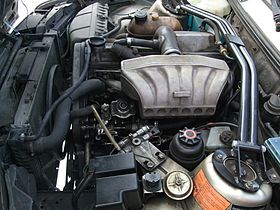BMW M21
| M21 | |
|---|---|
 | |
| Overview | |
| Manufacturer | BMW |
| Production | 1983–1991 |
| Layout | |
| Configuration | Inline-6 |
| Displacement | 2443 cm³ |
| Cylinder bore | 80 mm |
| Piston stroke | 81 mm |
| Cylinder block material | Cast iron |
| Valvetrain | OHC |
| Compression ratio | 22:1 |
| Combustion | |
| Turbocharger | Garret (85 kW engines only) |
| Fuel system | Swirl chamber injection |
| Fuel type | Diesel fuel |
| Cooling system | Water-cooled |
| Output | |
| Power output | 63 – 85 kW |
| Torque output | 152 – 220 Nm |
| Chronology | |
| Predecessor | None |
| Successor | M51 |
The BMW M21 is a six-cylinder-inline-diesel engine developed by the bavarian engine manufacturer BMW. The engine with swirl chamber injection is based on the otto engine M20[1] and was produced for BMW by the upper Austrian Steyr engine plant from 1983 to 1991. It was succeeded by the M51.[2]
Background
In the 1970s BMW decided to develop an engine, which would both be powerful and have a good fuel economy. This was caused by the oil crisis in 1973. In 1975 a group of BMW engineers started working on the M21 diesel engine, the otto engine M20 was taken as the basis. In 1983 at the IAA, the first passenger car was shown to the public which made use of the 85 kW M21. It was the E28 524td, which has a top speed of 180 km/h and reaches 100 km/h in 12,9 s. This 5er-BMW was the fastest series production diesel car in the world back in 1983. It has a fuel economy of 7,1 l /100 km.[2]
Technical description
The M21 is a water-cooled[3] six-cylinder-inline-diesel-engine with a cast iron block and OHC valvetrain. The camshaft is driven by a belt,[2] each cylinder has one inlet and one outlet valve.[1] Compared to the otto engine M20, the M21 has reinforced connecting-rods, cylinder heads, pistons, valves[2] and a reinforced crankshaft[1] with seven[3] bearings. For faster engine startup the M21 has a glowplug system called instant start, which reduces the time to reach starting temperature compared to similar diesel engines.[2] The fuel is injected into swirl chambers.[1] The mechanical injection was replaced in 1987 by an electronic diesel control system in the turbocharged engine.[4] The electronic diesel control results in better torque.[1] A Garret turbocharger[5] is used in the 85 kW engine, it lacks an intercooler. The engine with the EDC has a smaller turbocharger, which responds quicker.[1] Starting in 1985, BMW offered the M21 as a naturally aspirated engine, which was popular in countries with a high motor vehicle tax.[2]
| Engine | Bore × Stroke | Displacement | Compression | Rated Power | Max. Torque | Redline | Year |
|---|---|---|---|---|---|---|---|
| M21D24[3] | 80 × 81 mm | 2443 cm³ (149 in³) | 22:1 | 85 kW (114 hp) at 4800 min−1 | 210 N·m (155 lb·ft) at 2400 min−1 | 5350 min−1 | 1983 |
| 220 N·m (162 lb·ft) at 2400 min−1 | 5350 min−1 | 1987 | |||||
| 63 kW (84 hp) at 4600 min−1 | 152 N·m (112 lb·ft) at 2500 min−1 | 5150 min−1 | 1985 |
Applications:
- 1983 - 1988 E28 524td
- 1985 - 1993 E30 324d and 324td
- 1988 – 1991 E34 524td
- 1984 - 1985 Lincoln Continental Mark VII[4]
- 1984 - 1985 Lincoln Continental[4]
- 1986 - 1987 Vixen 21 TD and Vixen 21 XC[4]
- 1989 - 1991 Bertone Freeclimber
- 1992 UMM Alter II (Very rare UMM model, only 4 were made)
See also
References
- ^ a b c d e f Andreas in Bimmer: Die BMW-Sportdiesel: Von 524td E28 über 530d E39 bis BMW M550d F10, published at the 21st of January 2012, retrieved at the 9th of April 2015. (german)
- ^ a b c d e f Ronan Glon in RanWhenParked.net: 30 years ago: BMW introduces its first diesel engine, published at the 22nd of Juli 2013, retrieved at the 9th of April 2015.
- ^ a b c Meyer Motoren: BMW M21. Retrieved at the 9th of May 2016. (german)
- ^ a b c d BMW M21 engine page. Retrieved at the 9th of May 2016.
- ^ Auto Motor und Sport: Der zweite 5er von BMW: Die Baureihe E28 Der unscheinbare Revoluzzer, retrieved at the 9th of April 2015. (german)
